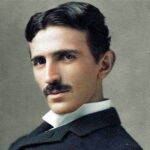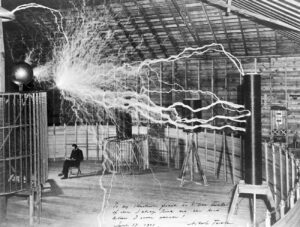 Sometimes, in the minds of geniuses, ideas can become lost or even stolen when the genius lacks the patience to promote their inventions to the world. They have innovated minds, but the marketing, patents, and mass-producing part is boring to them. Nikola Tesla, who was born on July 10, 1856, was such a scientist. Tesla was of Serbian nationality in Smiljan, within the Austrian Empire. He was considered one of the greatest and most enigmatic contributors to the development of electromagnetism and various scientific advancements of his era. Despite his impressive array of patents and discoveries, his contributions were frequently overshadowed during his life.
Sometimes, in the minds of geniuses, ideas can become lost or even stolen when the genius lacks the patience to promote their inventions to the world. They have innovated minds, but the marketing, patents, and mass-producing part is boring to them. Nikola Tesla, who was born on July 10, 1856, was such a scientist. Tesla was of Serbian nationality in Smiljan, within the Austrian Empire. He was considered one of the greatest and most enigmatic contributors to the development of electromagnetism and various scientific advancements of his era. Despite his impressive array of patents and discoveries, his contributions were frequently overshadowed during his life.
Nikola Tesla, a gifted student, attended the Austrian Polytechnic in Graz in 1875. He later moved to secure a job in Marburg, Slovenia. His challenging disposition occasionally surfaced, leading to a falling out with his family and a subsequent nervous breakdown. It is said that Tesla had an IQ of somewhere between 160 and 310 or “off the charts.” That makes it entirely possible that Tesla suffered with many mood swings. After leaving Slovenia, he registered at Charles Ferdinand University in Prague, only to leave once more without finishing his degree.
In his early years, he went through numerous bouts of sickness and bursts of striking inspiration. He frequently had visions of mechanical and theoretical inventions, often accompanied by intense flashes of light. His ability to visualize images in his mind was extraordinary. Instead of drafting plans or scale drawings for his projects, he depended on the vivid images in his imagination.
In 1880, he relocated to Budapest to work for a telegraph company. It was there that he familiarized himself  with twin turbines and contributed to the development of a device that amplified telephone signals. In 1882, he transferred to Paris to join the Continental Edison Company. During his tenure, he enhanced several Edison devices and devised the induction motor and other apparatuses utilizing rotating magnetic fields. Then, armed with a strong recommendation letter, Tesla arrived in the United States in 1884 to join the Edison Machine Works. There, he quickly rose to become a chief engineer and designer. Tasked with enhancing the direct current generators’ electrical system, Tesla was allegedly promised $50,000 for significant improvements. Despite fulfilling his task, Tesla was apparently not compensated, fueling a profound rivalry and resentment towards Thomas Edison. This animosity became a hallmark of Tesla’s life, affecting his financial standing and reputation. The intense feud is also cited as a contributing factor to why neither Tesla nor Edison received the Nobel Prize for their contributions to electrical engineering.
with twin turbines and contributed to the development of a device that amplified telephone signals. In 1882, he transferred to Paris to join the Continental Edison Company. During his tenure, he enhanced several Edison devices and devised the induction motor and other apparatuses utilizing rotating magnetic fields. Then, armed with a strong recommendation letter, Tesla arrived in the United States in 1884 to join the Edison Machine Works. There, he quickly rose to become a chief engineer and designer. Tasked with enhancing the direct current generators’ electrical system, Tesla was allegedly promised $50,000 for significant improvements. Despite fulfilling his task, Tesla was apparently not compensated, fueling a profound rivalry and resentment towards Thomas Edison. This animosity became a hallmark of Tesla’s life, affecting his financial standing and reputation. The intense feud is also cited as a contributing factor to why neither Tesla nor Edison received the Nobel Prize for their contributions to electrical engineering.
Disappointed by the lack of a pay raise, Tesla resigned and briefly worked digging ditches for the Edison telephone company. In 1886, he established his own company, which failed due to his investors’ lack of faith in alternating current (AC). The following year, Tesla experimented with a type of X-Ray technology, managing to photograph the bones in his hand and recognizing the harmful side-effects of radiation. Despite this, his work received minimal attention, and much of his research was destroyed in a fire at a New York warehouse.
Nikola Tesla was renowned for his intense work ethic and dedication to his work. He often dined alone and  seldom slept, sometimes only two hours per day. He never married, believing that his celibacy was beneficial to his scientific pursuits. In his later years, he adopted a vegetarian diet, subsisting solely on milk, bread, honey, and vegetable juices. In his lifetime, Tesla can be credited with many inventions, among them, the Tesla coil: A system for wireless transmission of electricity; the Tesla turbine: A type of turbine; the radio: Tesla demonstrated radio communication before Marconi; the Magnifying transmitter: A device for wireless energy transmission; and the Induction motor: A key component in modern devices. Tesla died on January 7, 1943, in a hotel room in New York City at the age of 86. After his death, in 1960 the General Conference on Weights and Measures named the SI unit of magnetic field strength the Tesla in his honor.
seldom slept, sometimes only two hours per day. He never married, believing that his celibacy was beneficial to his scientific pursuits. In his later years, he adopted a vegetarian diet, subsisting solely on milk, bread, honey, and vegetable juices. In his lifetime, Tesla can be credited with many inventions, among them, the Tesla coil: A system for wireless transmission of electricity; the Tesla turbine: A type of turbine; the radio: Tesla demonstrated radio communication before Marconi; the Magnifying transmitter: A device for wireless energy transmission; and the Induction motor: A key component in modern devices. Tesla died on January 7, 1943, in a hotel room in New York City at the age of 86. After his death, in 1960 the General Conference on Weights and Measures named the SI unit of magnetic field strength the Tesla in his honor.


One Response to Off The Charts